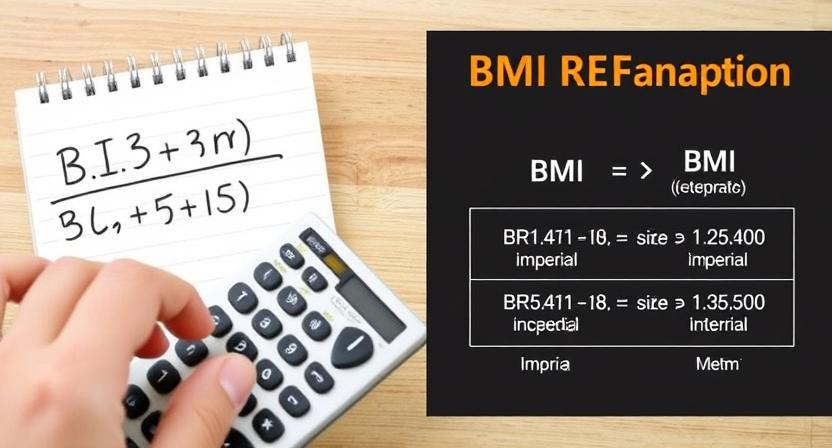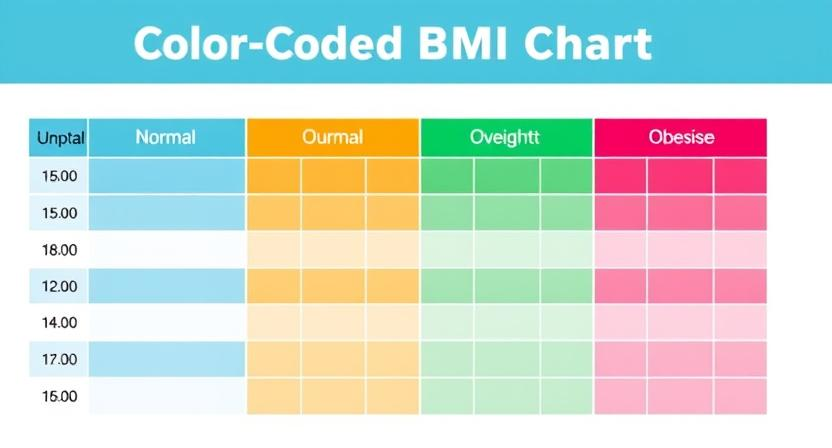Body Mass Index (BMI): Introduction
Body Mass Index (BMI). The mere mention of this three-letter acronym can trigger a range of emotions – anxiety, confusion, or even a sense of validation. In today’s world, BMI has become ubiquitous, appearing in medical check-ups, fitness articles, and countless online health tools. It is often presented as a convenient and straightforward method for gauging whether an individual’s weight falls within a “healthy” range. However, behind this seemingly simple metric lies a more complex and nuanced story.

While Body Mass Index can offer a quick glimpse into a person’s weight category, it is essential to recognize that it is far from a comprehensive or definitive measure of overall health. This article aims to provide a detailed examination of the Body Mass Index, exploring its historical origins, its calculation methods, its potential applications, and, most importantly, its well-documented limitations. By understanding both the advantages and disadvantages of BMI, we can learn to use it more responsibly as one component of a broader and more holistic approach to health assessment.
Table of Contents
What is Body Mass Index: A Historical Perspective
To truly grasp the significance and limitations of Body Mass Index, it is crucial to understand its historical context. The formula for Body Mass Index was originally developed in the 1830s by Adolphe Quetelet, a Belgian mathematician, statistician, sociologist, and astronomer. Quetelet was primarily interested in using this index, originally called the Quetelet Index, as a tool for describing the characteristics of a population, not for evaluating individual health. His goal was to identify the “average man” and understand the distribution of human characteristics within a population.
It’s important to recognize that Quetelet did not intend for his index to be used as a diagnostic tool for assessing the health of individual persons. His work focused on analyzing large datasets to identify statistical patterns across entire populations. The shift towards using Quetelet’s index for individual health assessment came later, with the rise of modern medicine and the increasing need for simple and accessible screening tools.
The Calculation of Body Mass Index: A Mathematical Overview
It is calculated using a relatively simple mathematical formula that takes into account an individual’s weight and height. While the concept is straightforward, it’s important to understand the precise formulas used in both the imperial and metric systems.

- Imperial Formula: This formula uses pounds (lbs) for weight and inches (in) for height.BMI = weight (lb) / [height (in)]2 x 703For example: If a person weighs 150 lbs and is 5 feet 5 inches tall (65 inches), their Body Mass Index (BMI) is calculated as follows:BMI = [150 / (65)2] x 703 = 24.96
- Metric Formula: This formula uses kilograms (kg) for weight and meters (m) for height.BMI = weight (kg) / [height (m)]2For example: If a person weighs 68 kg and is 165 cm tall (1.65 m), their BMI is calculated as follows:BMI = 68 / (1.65)2 = 24.98
It’s worth noting that while the formulas differ slightly depending on the unit of measurement, they both arrive at a similar final Body Mass Index (BMI) value for a given individual.
Interpreting Body Mass Index Results: Defining Weight Categories

Once the BMI value has been calculated, it is then compared to a predefined set of ranges to categorize an individual’s weight status. These categories are generally defined as follows for adults:
- Underweight: Body Mass Index less than 18.5
- Normal weight: Body Mass Index between 18.5 and 24.9
- Overweight: Body Mass Index between 25.0 and 29.9
- Obese: Body Mass Index 30.0 or higher
It is important to note that these categories are typically used for adults and that different interpretations apply to children and adolescents, where growth charts and percentiles are utilized to account for the changing body composition during development.
Potential Applications of Body Mass Index (BMI): A Screening Tool for Population Health

Despite its limitations, Body Mass Index (BMI) has served as a useful tool in population health assessments and large-scale epidemiological studies. Because it is inexpensive and easy to calculate, BMI can be used to screen large populations for potential weight-related health risks.
- Epidemiological Studies: Body Mass Index (BMI) has been extensively used in epidemiological studies to assess the prevalence of overweight and obesity in different populations and to examine the relationship between BMI and various health outcomes.
- Public Health Surveillance: Public health agencies often use BMI data to monitor trends in obesity rates and to develop targeted interventions aimed at promoting healthy weight.
- Clinical Screening: In some clinical settings, Body Mass Index (BMI) is used as a preliminary screening tool to identify individuals who may be at increased risk for weight-related health problems. However, it should never be used as the sole basis for making medical diagnoses or treatment decisions.
The Limitations of BMI: A Critical Evaluation
While BMI may offer a quick snapshot of weight status, it is essential to acknowledge its numerous limitations and to avoid relying on it as the sole determinant of individual health. Here are some of the most significant shortcomings of Body Mass Index (BMI):
- Inability to Differentiate Muscle Mass from Fat Mass: One of the most significant limitations of BMI is that it cannot distinguish between muscle mass and fat mass. This is a critical flaw, as individuals with high muscle mass, such as athletes and bodybuilders, may be classified as overweight or obese based on their Body Mass Index (BMI), even though they have a low percentage of body fat.
- Failure to Account for Body Composition: BMI fails to account for the distribution of body fat. Individuals who carry a significant amount of abdominal fat (visceral fat) are at higher risk for certain health problems, such as heart disease and type 2 diabetes, even if their BMI is within the normal range.
- Neglecting Individual Factors: BMI does not consider individual factors such as age, gender, ethnicity, and genetics, all of which can influence body composition and health outcomes. The “normal” BMI range may not be appropriate for all individuals.
- Oversimplification of a Complex Issue: By reducing a person’s health status to a single number, BMI oversimplifies the complex interplay of factors that contribute to overall well-being. It fails to capture important aspects of health such as blood pressure, cholesterol levels, blood sugar control, physical fitness, and mental health.
Exploring Alternative Measures of Body Composition
Given the limitations of BMI, it is often beneficial to explore alternative methods for assessing body composition and overall health. These methods can provide a more detailed and nuanced picture of an individual’s body fat percentage, muscle mass, and fat distribution.
- Skinfold Measurements: This simple and inexpensive method involves using calipers to measure the thickness of subcutaneous fat at various sites on the body. While it requires trained personnel and standardized techniques, skinfold measurements can provide a reasonable estimate of body fat percentage.
- Bioelectrical Impedance Analysis (BIA): This non-invasive method uses a small electrical current to estimate body composition. BIA devices measure the resistance to the flow of the current, which is influenced by body water, lean mass, and fat mass. While BIA is convenient and relatively affordable, it can be affected by hydration status and other factors.
- Dual-Energy X-ray Absorptiometry (DEXA): This imaging technique, which is primarily used for measuring bone density, can also provide a highly accurate assessment of body composition. DEXA scans can determine the amount of bone mineral, lean mass, and fat mass in different regions of the body. However, DEXA is more expensive and less accessible than other methods.
- Waist Circumference: Measuring waist circumference provides valuable information about abdominal fat distribution. A high waist circumference is associated with an increased risk of cardiovascular disease, type 2 diabetes, and other metabolic disorders.
Beyond Body Composition: A Holistic Approach to Health Assessment
While body composition measurements can offer a more detailed picture of an individual’s physique, it is crucial to remember that health is more than just a number or a percentage. A truly comprehensive assessment of health should encompass a variety of factors, including:
- Lifestyle Factors: These include diet, exercise habits, sleep quality, stress levels, and smoking and alcohol consumption.
- Medical History: This includes past illnesses, surgeries, and family history of disease.
- Physical Examination: A thorough physical examination can reveal important clues about an individual’s health status.
- Laboratory Tests: Blood tests can provide valuable information about cholesterol levels, blood sugar control, hormone levels, and other important health markers.
- Mental and Emotional Well-being: Mental health conditions, such as depression and anxiety, can have a significant impact on physical health.
The Importance of Consulting with Healthcare Professionals
The information provided in this article is intended for general knowledge and informational purposes only, and does not constitute medical advice. It is essential to consult with qualified healthcare professionals, such as physicians, registered dietitians, and certified personal trainers, for personalized guidance on weight management, exercise, and overall health.
Healthcare professionals can assess your individual needs and circumstances, provide evidence-based recommendations, and help you develop a comprehensive plan that is tailored to your specific goals and preferences. They can also help you interpret your BMI and other health metrics in the context of your individual health history and risk factors.
Conclusion: A Balanced Perspective on Body Mass Index (BMI)
It is a tool that has its uses and limitations. It’s a simple, inexpensive calculation that can provide a quick snapshot of weight status. However, it is essential to recognize that Body Mass Index (BMI) is not a definitive measure of health and should not be used in isolation to make medical diagnoses or treatment decisions. By understanding the strengths and weaknesses of BMI, we can use it more responsibly as one piece of information in a larger and more comprehensive picture of overall health.
FAQs About BMI and Weight Management
Calculating Body Mass Index (BMI):
- How do I calculate my Body Mass Index (BMI)?
- Imperial: Weight (lb) / [Height (in)]² x 703
- Metric: Weight (kg) / [Height (m)]²
- How to calculate actual Body Mass Index (BMI)?
“Actual BMI” is calculated by plugging your precise weight and height measurements into the BMI formula (see above). - What is the BMI formula?
- Imperial: BMI = weight (lb) / [height (in)]² x 703
- Metric: BMI = weight (kg) / [height (m)]²
- What is the Body Mass Index (BMI)in kg?
This is a bit ambiguous. What you need to do is use the metric BMI formula: Weight (kg) / [Height (m)]²
Body Mass Index (BMI) Ranges & Interpretation:
- What is a normal Body Mass Index (BMI)?
A normal BMI is considered to be between 18.5 and 24.9. - What is a good Body Mass Index (BMI) by age?
The “good” BMI range (18.5 – 24.9) is generally the same for all adults, but it’s important to remember that BMI has limitations and individual health factors should be considered. BMI is different for children as growth charts are used. - How much BMI is ok?
A BMI between 18.5 and 24.9 is generally considered “ok,” indicating a healthy weight range. - What is an unsafe Body Mass Index (BMI)?
A BMI below 18.5 (underweight) or above 30 (obese) is generally considered unsafe and indicative of potential health risks. However, interpretation always requires context and consultation with a healthcare professional. - Is the Body Mass Index (BMI) calculator correct?
The BMI calculation itself is mathematically correct, but its interpretation and application as a measure of health has limitations. It provides a number based on height and weight but doesn’t consider body composition or other individual health factors.
Weight & Health:
- Is 70kg overweight?
Whether 70kg is overweight depends on the person’s height. Calculate the BMI: Weight (kg) / [Height (m)]². Then look at the BMI Ranges in the article above to measure whether you are in the “Normal”, “Overweight” or “Obese” range. - How much should a 5’2″ female weigh?
A 5’2″ female would have a normal BMI when weighing between 100 and 134 pounds. - What is the Body Mass Index (BMI) of 70 kg?
You cannot determine someone’s BMI with only their weight (70kg). You must also include their height. - Is 67 kg heavy for a girl?
Whether 67 kg is “heavy” depends on the girl’s height and body composition. It is best to seek medical advice when understanding the recommended weight. - Why am I heavy but not fat?
You may be heavy but not fat if you have a high muscle mass. Muscle is denser than fat, so it contributes more to overall weight.
Obesity:
- What are the 4 types of obesity?
While not an official “medical” classification, obesity can be discussed in terms of contributing factors such as;- Genetic, where there may be genetic predispositions to weight gain.
- Environmental where dietary patterns and lack of physical activity are contributors.
- Metabolic due to metabolic irregularities and hormonal imbalances.
- Behavioral relating to various mental health conditions contributing to eating disorders.
- What are 10 causes of obesity?
Some of the causes include;- Unhealthy Diet (high in processed foods, sugary drinks, and saturated fats)
- Lack of Physical Activity
- Genetics and Family History
- Metabolic Factors (e.g., insulin resistance)
- Hormonal Imbalances
- Certain Medications
- Sleep Deprivation
- Stress
- Socioeconomic Factors
- Age
- How many kg am I overweight?
To determine how many kg you are overweight, you need to calculate your BMI first. Then, you can compare your current weight to the weight range associated with a “normal” BMI for your height.
Weight Loss & Management:
- How to lower Body Mass Index (BMI)?
Lowering BMI involves reducing weight, which is best achieved through a combination of:- Adopting a healthy diet (focused on whole foods, portion control)
- Engaging in regular physical activity (cardio and strength training)
- Managing stress
- Getting enough sleep
- How to burn belly fat?
- Engage in regular cardio exercise
- Do strength training exercises
- Reduce simple carbs
- Eat fiber and nutrients
- Control stress levels
- Does drinking water lower Body Mass Index (BMI)?
Drinking water alone won’t directly lower BMI, but it can support weight management by promoting fullness, aiding digestion, and boosting metabolism. - How to lose 1kg a week?
Losing 1 kg (approximately 2.2 pounds) per week typically requires creating a calorie deficit of around 500-750 calories per day through diet and exercise.
